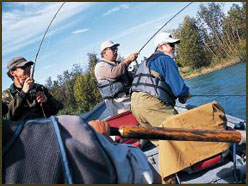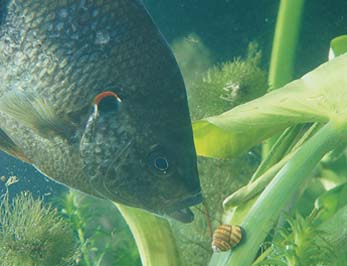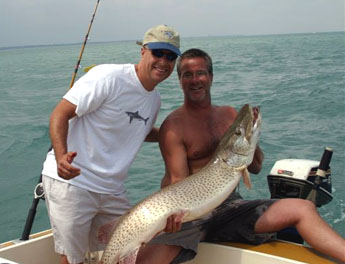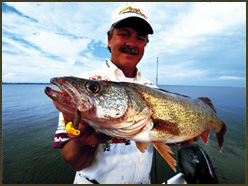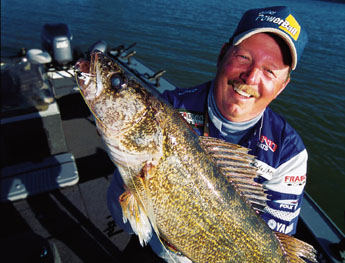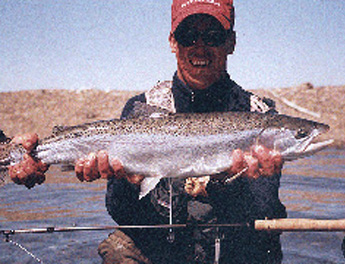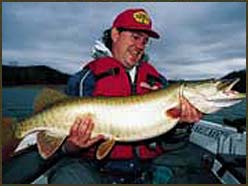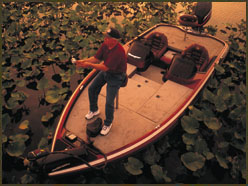Cowlitz Steel
Action that just won’t stop.
WASHINGTON Summer steelhead action on the Cowlitz River goes for several months. You can fish from the bank near the dam-drift eggs and shrimp. Boaters can target steelhead in large holding pools. Good drifts exist between the salmon and trout hatcheries. You can keep two steelhead at least 20 inches long per day. Return all steelhead with a clipped right ventral fin or intact adipose fin.
Good fish often come out the Middle Cowlitz downstream from the salmon hatchery barrier dam near Salkum. There is no closed season on steelhead. Troll herring or a Flatfish lure for chinook, cohos and steelhead. Be sure to read all the state rules for the Cowlitz.
Contact: Washington Department of Fish and Wildlife (360-696-6211). -Scott Staats
Salmon Double
Set course for Cordova
**ALASKA **The town of Cordova means can’t-miss salmon. Chinook salmon swim throughout Prince William Sound in June and July, with the fish running 20 to 40 pounds. Then, starting in early July, good numbers of sockeye (red) salmon run in the Eyak River, right through Cordova.
Sport-fishing charter boats at the Cordova Boat Harbor cost about $50 per person for half-day trips to about $100 per angler for all-day excursions. Charters usually provide tackle; most anglers use downriggers and cut-plug herring trolled behind flashers for the hungry kings.
Once you take your limit of kings, head to the Eyak River for sockeyes. The 6- to 12-pound sockeyes hit small streamers, or you can go after them with spinning tackle and small spinners and Pixie spoons. Focus on the lower five miles of the Eyak. Contact: Cordova Chamber of Commerce (907-424-7260); Alaska Department of Fish and Game (907-424-3212). -Gary Kramer
Feel Free to Think Big
Antero Reservoir trout are the kind you hang on walls.
COLORADO Twitch a leech imitation near shoreline weeds or rip a silver Krocodile spoon through deeper water of Antero Reservoir in South Park for some of the largest trout in the state. And Antero’s big-fish reputation should be even more certain following a regulation change that takes effect June 1: Anglers will be able to keep only one fish over 16 inches. According to gill-net samples taken in 2000, about 30 percent of Antero’s trout top 16 inches, and the bigger fish weigh as much as 10 pounds.
“Antero is a relatively shallow lake that has a whole soup of aquatic insects, and growth rates are pretty phenomenal,” says Robin Knox, Colorado Division of Wildlife sport-fisheries coordinator. “Antero primarily contains rainbows and browns, plus Snake River cutthroats and splake [BRACKET “the colorful, sterile hybrids of brook and lake trout”].
The best fishing occurs just as the ice comes off the 9,000-foot-high lake, but catch rates remain strong through June, when surface temperatures rise and trout tend to sulk in the deeper spots of the lake. Until then, fish worms and PowerBait or flavored marshmallows from shore, or cast silver- and copper-colored spoons. Flyfishermen can score with scuds or streamers such as Muddler Minnows or Zonkers. Go deep with plugs and spoons as the water warms.
Contact: Colorado Fisheries Division (303-291-7355). -Andrew McKean
Sky-Rocket Trout
South Fork on the rise.
IDAHO Whether you use flies, bait or hardware, the time to catch a South Fork Snake River trout comes on either side of Independence Day. That’s when the big stonefly hatch usually kicks up and you’ll have the chance to catch cutthroats on the surface with flies the size of a wine cork. Also, the river’s larger browns will slam Rapalas and big Panther Martin spinners or a variety of baits, including bullheads and hellgrammites.
The first stoneflies show near Menan during the final week of June; the hatch might last as feas 10 days. Good fly patterns are the old-time Super Renegade, the Madame X on top or Yuk Bugs under the surface. But the best big-fish lure is a gold No. 7 Countdown Rapala. Idaho’s state-record brown, a 26-pound, 6-ouncer, came out of the South Fork, and 18- to 24-inch fish aren’t uncommon. Contact: Fin-Chasers, Idaho Falls (208-557-0333); Idaho Fish and Game, Upper Snake Region (208-525-7290). -A.K.
The Umpqua Brawl
Shad and smallmouths take no prisoners.
OREGON Few fish fight as hard for their size as shad and smallmouths. The last two weeks of June can provide some major battles on the Umpqua River.
The shad range from two to four pounds and can reach six pounds. Target the bigger holes below where shelf rock crosses the river. Anchor boats in pools and fish downstream in front of the boat. For great action, try ultralight rods with 6-pound-test using curly-tail jigs on eighth-ounce jigheads in pink and chartreuse. Place split shots 18 inches above the jigheads. Fly-rodders use three- or four-weight sinking-head line. Smallmouth bass are found throughout the entire stretch of river. Bounce purple plastic worms off the bottom or cast Rapalas at the drop-offs near shore. Fish over five pounds are not uncommon. The bass get active when water temperatures reach 50 to 55 degrees.
Contact: Gary’s Guide Service (877-672-2460). -S.S.
Summertime Bugs
The Blackfoot River is hot all June and July
**MONTANA ** June and July see big-bug hatches on the Blackfoot River that can’t be missed. The bugs are easy to see when floating and big fish show up to eat, and your casts don’t have to be delicate or perfect.
In June as runoff roils the Blackfoot all the way to Ovando, watch for big adult salmonflies on the surface and dredge large, rubber-legged stonefly nymphs along the shoreline cobble. In July, the golden stoneflies come up. Try bead-head Golden Stone nymph patterns or yellow Stimulators. Later in July, grasshopper patterns and natural-colored hardware fool west-slope cutthroat trout and lesser numbers of rainbows and browns (release all bull trout).
The Blackfoot, born on the Continental Divide east of Lincoln, bends its way to the Clark Fork near Missoula. A half-dozen white-water stretches along its route can bump you into boulders, so if you float, do it in a rubber raft rather than a hard-sided boat. Best floats, for a mix of top fishing, great scenery and semi-technical water, are from Russell Gates to Roundup, from Roundup to River Bend and from Johnsrud to Bonner.
Contact: CrossCurrents Fly Shop in Helena (406-449-2292); Montana Fish, Wildlife & Parks in Missoula (406-542-5500). -A.M. Notes From Afield
Bronzebacks in downtown Seattle
I always get on the water early to hook into June’s topwater smallmouth bite on Lake Washington and the smaller Lake Sammamish right in the heart of Seattle. It’s fast and furious action and the only thing that can take me away from chasing steelhead in the summertime.
Darkness or cloudy skies are key. Once the sun is up, the smashing strikes on your buzzbaits and topwater stickbaits will subside. On overcast days burn a willow-leaf spinnerbait by pilings, docks and other fishy cover. Or try chartreuse spinnerbaits; chartreuse causes smallmouths to suffer some kind of hunger spasm. On these two lakes overcast skies are the one situation in which this garish color will catch fish. Normally, white-colored spinnerbaits with a touch of blue are the best producers. You can access Lake Washington easily at the Gene Coulon Memorial Beach Park launch. Also launch at Lake Sammamish State Park to get on Sammamish.
Contact: Western Bass Club (253-531-2284). -John Snow
Alaska
Soldotna Kings: You know there will be some crowds, but quality king salmon fishing in the Kenai River near Soldotna in June and July can’t be topped. These fish average 30 pounds and sometimes top 60. Access the Kenai from River Mile 12 to Cook Inlet. Toss Quick Fish lures or Vibrax spinners on at least 20-pound line. Contact: Alaska DFG (907-262-9368).
Independence Day Pinks: About two hours north of Anchorage off the Parks Highway, try Willow Creek for pink salmon fishing starting in early July. The four- to six-pound salmon will hit small Pixie spoons and Vibrax spinners and are great sport on light tackle. Contact: Alaska DFG (907-746-6300).
New Chinook Limits: The Alaska Board of Fisheries adopted a new regulation for 2002 creating an annual limit of five chinook (king) salmon 20 inches or more throughout much of Alaska in both fresh and salt water. Increased chinook harvest of mixed stocks was cited as the major reason for the new regulation.
Key Dates
June 11: Fishing opens on the Upper Kenai River system (Kenai Lake to Skilak Lake), and on the Russian River.
Arizona
Roosevelt Flatties: In June, flathead hunters head to Roosevelt Lake, northwest of Globe. The cats average 8 to 12 pounds but can top 50. Start out where the Salt River enters the lake. Use live carp or bluegills fished on the bottom with a half-ounce of lead. Contact: Arizona GFD (602-942-3000).
Havasu Stripers: As the weather heats up, look for striped bass chasing baitfish, particularly in the Topock region of Lake Havasu. Use Zara Spooks and Pencil Poppers for fish that average two to three pounds, with a few in the five-pound-plus range. Take a set of binoculars to look for surface commotion and birds diving. Contact: Arizona GFD (602-942-3000).
Applications Due: Postmarks do not count for the deadline for submitting big-game hunt applications by June 11 at 7 p.m. You can get an application form online at www.azgfd.com. To participate in the bonus point system you must purchase a license when you apply.
Eat Crayfish: Remember the new rule: Transporting live crayfish in state is illegal except in some southwestern parts of Arizona. The non-native crayfish has devastated various high-country trout streams by denuding them of vegetation. Anglers are encouraged to catch, use and eat all the crayfish they can. Contact: Arizona Game and Fish (602-942-3000).
Key Dates
June 7: Big-game hunt applications due by 7 p.m.
June 8: Free fishing day.
California
Eagle Rainbows: Eagle Lake supports a unique strain of rainbow trout that is adapted to the alkaline waters of this 30,000-acre natural lake. Boat, float-tube and wade fishermen can all find good access. Toss leech, scud and Woolly Bugger flies in sizes 6 through 12.
Motels and restaurants arrowds, but quality king salmon fishing in the Kenai River near Soldotna in June and July can’t be topped. These fish average 30 pounds and sometimes top 60. Access the Kenai from River Mile 12 to Cook Inlet. Toss Quick Fish lures or Vibrax spinners on at least 20-pound line. Contact: Alaska DFG (907-262-9368).
Independence Day Pinks: About two hours north of Anchorage off the Parks Highway, try Willow Creek for pink salmon fishing starting in early July. The four- to six-pound salmon will hit small Pixie spoons and Vibrax spinners and are great sport on light tackle. Contact: Alaska DFG (907-746-6300).
New Chinook Limits: The Alaska Board of Fisheries adopted a new regulation for 2002 creating an annual limit of five chinook (king) salmon 20 inches or more throughout much of Alaska in both fresh and salt water. Increased chinook harvest of mixed stocks was cited as the major reason for the new regulation.
Key Dates
June 11: Fishing opens on the Upper Kenai River system (Kenai Lake to Skilak Lake), and on the Russian River.
Arizona
Roosevelt Flatties: In June, flathead hunters head to Roosevelt Lake, northwest of Globe. The cats average 8 to 12 pounds but can top 50. Start out where the Salt River enters the lake. Use live carp or bluegills fished on the bottom with a half-ounce of lead. Contact: Arizona GFD (602-942-3000).
Havasu Stripers: As the weather heats up, look for striped bass chasing baitfish, particularly in the Topock region of Lake Havasu. Use Zara Spooks and Pencil Poppers for fish that average two to three pounds, with a few in the five-pound-plus range. Take a set of binoculars to look for surface commotion and birds diving. Contact: Arizona GFD (602-942-3000).
Applications Due: Postmarks do not count for the deadline for submitting big-game hunt applications by June 11 at 7 p.m. You can get an application form online at www.azgfd.com. To participate in the bonus point system you must purchase a license when you apply.
Eat Crayfish: Remember the new rule: Transporting live crayfish in state is illegal except in some southwestern parts of Arizona. The non-native crayfish has devastated various high-country trout streams by denuding them of vegetation. Anglers are encouraged to catch, use and eat all the crayfish they can. Contact: Arizona Game and Fish (602-942-3000).
Key Dates
June 7: Big-game hunt applications due by 7 p.m.
June 8: Free fishing day.
California
Eagle Rainbows: Eagle Lake supports a unique strain of rainbow trout that is adapted to the alkaline waters of this 30,000-acre natural lake. Boat, float-tube and wade fishermen can all find good access. Toss leech, scud and Woolly Bugger flies in sizes 6 through 12.
Motels and restaurants ar
